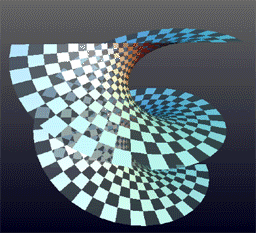Catenoid


A catenoid is a surface in 3-dimensional Euclidean space arising by rotating a catenary curve about its directrix (see animation on the right). Not counting the plane, it is the first non-trivial minimal surface to be discovered. It was found and proved to be minimal by Leonhard Euler in 1744.[1]
Early work on the subject was published also by Jean Baptiste Meusnier.[2] There are only two minimal surfaces of revolution (surfaces of revolution which are also minimal surfaces): the plane and the catenoid.[3]
The catenoid may be defined by the following parametric equations:
- where and and is a non-zero real constant.
In cylindrical coordinates:
- where is a real constant.
A physical model of a catenoid can be formed by dipping two circles into a soap solution and slowly drawing the circles apart.
The catenoid may be also defined approximately by the Stretched grid method as a facet 3D model.
Helicoid transformation

Because they are members of the same associate family of surfaces, one can bend a catenoid into a portion of a helicoid without stretching. In other words, one can make a (mostly) continuous and isometric deformation of a catenoid to a portion of the helicoid such that every member of the deformation family is minimal (having a mean curvature of zero). A parametrization of such a deformation is given by the system
- for , with deformation parameter ,
where corresponds to a right-handed helicoid, corresponds to a catenoid, and corresponds to a left-handed helicoid.
Architecture

The Inuit learned to develop their igloo structures by implementing a catenary of revolution shape which offers optimal balance between height and diameter of the structure without risk of collapsing under the weight of compacted snow.[4] This is slightly different from what is typically called a catenoid in that the catenary is rotated about its center, forming a surface with the topology of a bowl rather than that of a cylinder.
References
- ↑ Eulero, Leonhardo (1952) [1744]. Carathëodory, ed. Methodus inveniendi lineas curvas : maximi minimive proprietate gaudentes sive solutio problematis isoperimetrici latissimo sensu accepti [A method for finding the property of maxima or minima of curves and, as the sense of receiving, or Solution of isoperimetric problems in the broadest sense] (in Latin). 24 (MDCCXLIV ed.). Bernae: Orell Füssli Turici. ISBN 9783764314248. Archived from the original on archivedate. Retrieved 1 August 2015. Check date values in:
|archive-date=(help) - ↑ Meusnier, J. B (1881). Mémoire sur la courbure des surfaces [Memory on the curvature of surfaces.] (PDF) (in French). Bruxelles: F. Hayez, Imprimeur De L'Acdemie Royale De Belgique. pp. 477–510. ISBN 9781147341744.
- ↑ Catenoid at MathWorld
- ↑ Handy, Richard L. (Dec 1973). "The Igloo and the Natural Bridge as Ultimate Structures" (PDF). Arctic. Arctic Institute of North America. 26 (4): 276–277. doi:10.14430/arctic2926.
External links
- Hazewinkel, Michiel, ed. (2001), "Catenoid", Encyclopedia of Mathematics, Springer, ISBN 978-1-55608-010-4
- Catenoid - WebGL model
